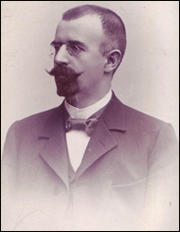Colonial Africa in the offing
Hans P. Krag and his financial dynasty

Main content
Kirsten Alsaker Kjerland
Kirsten.Kjerland@uni.no
In 1877, Løvenskiold, one of the most important timber and board entrepreneurs in Christiania, took on a new, twenty year old trainee. He had no former experience in the trade, but displayed very soon an unusual eagerness to learn. Within a year he was sent to England as their agent. In 1887 the former trainee - with an official commercial scholarship from the Norwegian Government in his pocket - set out for North Africa to study options for export of Scandinavian and Russian plank.
Besides a lengthy report to the Norwegian authorities, this journey secured Hans Peter Fyhn Krag a very successful supply contract exporting wood briquettes to the mining industry in Egypt. Soon thereafter he also began selling Finnish, Russian and Norwegian plank to Algeria and Tunisia and bought his first stocks in a Swedish timber-related-agency with branches in several North African cities. By 1914 Krag had business in the north, east and south of Africa. He was also a shareholder in timber-related businesses in Finland, France and Norway, and was finally deeply involved in Norwegian shipping.
When Krag died in 1938, most of his African businesses paid off well. The exception were his plantations, which throughout had been experiencing varying success. After the Second World War, due to high prices of primary products on the world market, his heirs also harvested prosperously from these. By 1980 waves of nationalization forced Krag’s heirs to wind up in Algeria, Tunis and Kenya. Their remaining timber-related shops and industries, plantations and extraction of mineral were then located in the very south of the African continent (Mozambique and South Africa). By 2005 only South Africa remains.
Hans Peter Fyhn Krag was no globetrotter. He lived in England for a short while and made a number of trips to Africa before the First World War. After his marriage to Augusta Julie Georgine Heffermehl in 1891 his travelling gradually abated.
Krag therefore ran his African business via Norwegian agents; an arrangement rather common for both private and public sector at the time. Similarly to the ship owners described by Gordon Boyes in “Information, Mediation and Institutional Development” (1995), Krag sat at home, provided his agents the money needed and associated with men at home who supported him in the effort. The main merit of the agent was his detailed knowledge and control of the local context. He was to work for the benefit of the principal, not for rivals or his own gain. The relationship rested on deep loyalty. Boyes further points out that friendships often emerged between principal and agent, even if they belonged to different economic strata. Krag treated many of the agents in a son-like manner and he ruled his paternalistic dynasty with a firm, but kind hand.
Most Norwegian agents in the Krag Company were very loyal and remained in service until they reached the age of retirement. The reasons why are manifold, but it is evident that their wages were high and living conditions superb. They earned far more than colonial district officers in the colonies where they worked at the time, and much better than Norwegians in Norway doing similar types of jobs. The holiday terms were those of all colonial personnel; 6 month’s paid leave every third year and voyage to and from Africa covered for the agent and his family. All lived in grand mansions, in high society colonial neighbourhoods. A number of the Krag’s agents, moving from low to higher strata, failed to invest and spend most of their surplus money trying to match the requirement of their surroundings. This may explain why some of them came out empty handed. Others were forced to abandon properties in which they had invested their surplus when colonialism came to an end.
As time passed, most of these agents became homeless in another sense too. After years in a small white colonial setting, the agents felt alien to the social-political development in Europe. Their children, born in Africa, did not understand Norwegian laws and post-war philosophy of equality and this caused unwillingness and inability to return to Norway. Quite a few – after having tried various African countries – ended up in Australia and New Zealand. Just like Karen Blixen, who in the novel “Sorg Agre” in 1943, idealized a feudal society, the sons and daughters of Krag‘s agents sought societies in which they formed the “natural” elite.
Hans Peter Fyhn Krag earned very good money and is considered a prominent member of the Norwegian plank gentry. This is firmly stated by Knut Sogner in “Plankeadel; Kiær og Solbergfamilien og den 2. industrielle revolusjon” (2001). This book sheds light on a group of largely forgotten, understudied and unexpectedly wealthy group of Norwegian entrepreneurs; an economic aristocracy – according to Sogner – with a much larger say in the making of modern Norway than previously anticipated. So far the creation of the Norwegian nation has been closely connected to the cultural aristocracy and political elite. Accordingly, men like Gunnar Knudsen and Christian Michelsen figure mainly in their capacities as politicians rather than as industrialist and ship-owner respectively. It is of central importance to the present project to to find out how influential Krag and his close associates were; in Norway and also in the colonies in which they traded and invested. A prime aim is to find out how Krag‘s dynasty worked, and how large it was. Its full extent is presently unknown, but it is reason to believe (as does his grandchild) that he had a finger in every Norwegian-African pie. It remains to be seen if anyone helped him get started and also when and on what he earned his best money.
